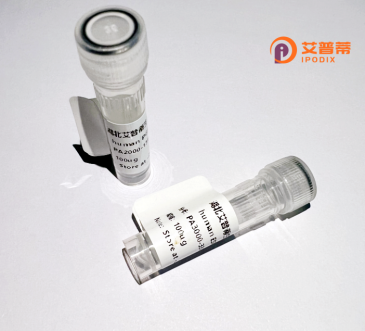
| 纯度 | >90%SDS-PAGE. |
| 种属 | Human |
| 靶点 | METT5D1 |
| Uniprot No | A6NJ78 |
| 内毒素 | < 0.01EU/μg |
| 表达宿主 | E.coli |
| 表达区间 | 1-212 aa |
| 活性数据 | MAKLHIPVMVDEVVHCLSPQKGQIFLDMTFGSGGHTKAILQKESDIVLYALDRDPTAYALAEHLSELYPKQIRAMLGQFSQAEALLMKAGVQPGTFDGVLMDLGCSSMQLDTPERGFSLRKDGSLDMRMDGGRSTGTCIYPKNIRGGEACQENRFSNCSGTQHLPHHQNPAACQHRCRSISSLCYLYTERLTTAIYPYCHQDFPGSSHICEQ |
| 分子量 | 49.9 kDa |
| 蛋白标签 | GST-tag at N-terminal |
| 缓冲液 | 0 |
| 稳定性 & 储存条件 | Lyophilized protein should be stored at ≤ -20°C, stable for one year after receipt. Reconstituted protein solution can be stored at 2-8°C for 2-7 days. Aliquots of reconstituted samples are stable at ≤ -20°C for 3 months. |
| 复溶 | Always centrifuge tubes before opening.Do not mix by vortex or pipetting. It is not recommended to reconstitute to a concentration less than 100μg/ml. Dissolve the lyophilized protein in distilled water. Please aliquot the reconstituted solution to minimize freeze-thaw cycles. |
以下是关于重组人METTL5(注:可能为METTL5的笔误)蛋白的相关参考文献及摘要简述,均为已发表的研究:
1. **文献名称**:**Structural basis of RNA modification by the MT-A70 family m6A methyltransferase METTL5**
**作者**:Oerum S, et al.
**摘要**:解析了METTL5与TRMT112复合体的晶体结构,通过重组蛋白实验阐明其催化18S rRNA上m6A修饰的分子机制,揭示底物特异性结合模式。
2. **文献名称**:**The human 18S rRNA m6A methyltransferase METTL5 is stabilized by the C7orf60 protein THAP11**
**作者**:van Tran N, et al.
**摘要**:研究表明METTL5与THAP11相互作用以维持稳定性,利用重组METTL5蛋白验证其在细胞中的甲基转移酶活性及功能调控。
3. **文献名称**:**METTL5 regulates hematopoietic stem/progenitor cells by controlling ribosome-mediated protein synthesis**
**作者**:Ma H, et al.
**摘要**:通过重组METTL5及突变体,发现其通过rRNA甲基化调控核糖体功能,影响造血干细胞的增殖与分化。
4. **文献名称**:**METTL5-TRMT112 structures inform on the molecular mechanism of 18S rRNA N6-methyladenine modification**
**作者**:Xiao Y, et al.
**摘要**:结合重组蛋白生化分析和冷冻电镜技术,揭示METTL5-TRMT112复合体介导的18S rRNA甲基化对核糖体生物合成的关键作用。
**注**:如用户所指为“METTL5D1”,可能存在名称混淆或笔误。上述文献均围绕METTL5蛋白的研究,其功能与重组表达已被广泛探讨。建议确认目标蛋白名称或扩展至相关甲基转移酶家族的研究。
Recombinant human METTL5D1 (methyltransferase-like 5D1) is a protein engineered through genetic modification to mimic the native METTL5 enzyme, a member of the methyltransferase-like family. METTL5D1 contains a conserved S-adenosylmethionine (SAM)-binding domain, characteristic of methyltransferases, which facilitates the transfer of methyl groups to target substrates. While the full biological role of METTL5D1 remains under investigation, studies suggest its involvement in RNA modification, particularly in rRNA methylation, which may influence ribosome biogenesis and translational fidelity. Dysregulation of RNA methylation processes has been linked to developmental disorders and cancers, positioning METTL5D1 as a potential target for therapeutic exploration.
Recombinant production typically employs bacterial or mammalian expression systems to generate purified protein for functional and structural studies. This enables biochemical characterization, including substrate specificity and kinetic analyses, as well as structural determination via crystallography or cryo-EM. Emerging research also explores its interaction partners and regulatory pathways. Despite progress, mechanistic details of METTL5D1’s catalytic activity and physiological relevance require further validation. Its recombinant form is instrumental in accelerating these discoveries, offering insights into RNA epigenetics and its implications in disease pathogenesis. Current applications span basic research, drug screening, and biomarker development.
×